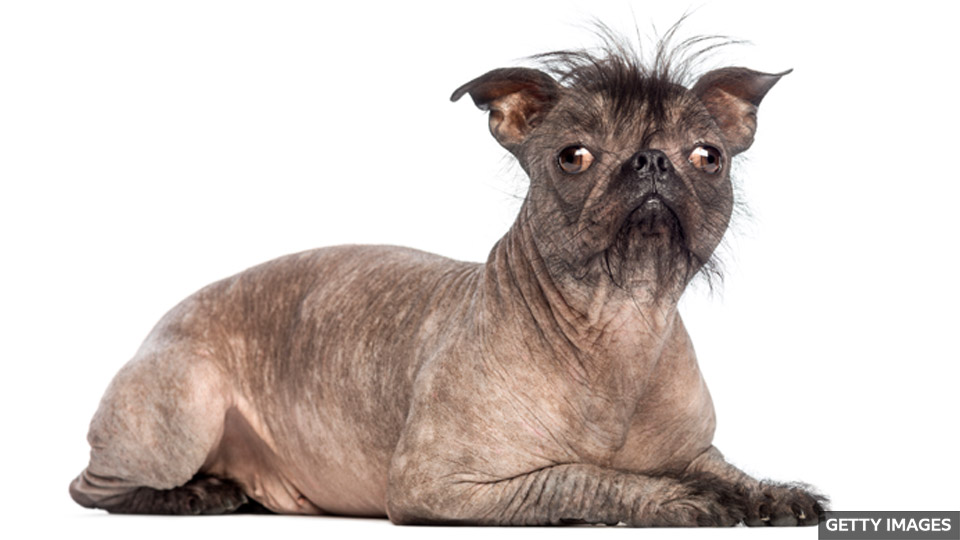随身英语
The ugly-cute phenomenon – what is our obsession with ugly pets? “又丑又可爱” 现象——我们为什么痴迷于长得丑的宠物?

大多数时候,我们都喜欢更加美丽的事物。那么,为什么在美国的加利福尼亚地区每年都会举办 “世界最丑狗狗” 比赛呢?为什么我们又会选择养育那些与完美的外表相去甚远的宠物?本文介绍人类与这些既丑又惹人怜爱的宠物之间复杂的历史和情感关系。
词汇:animal appearance 动物的外观
In a world that favours beauty, from aesthetically pleasing interior design to an attractive physical appearance, why are we suddenly fawning over goofy-looking pets, particularly dogs, with exaggerated features? There's been a pet paradigm shift – perfection is out, and droopy eyes are in. What's going on?
First, we must understand our attraction to cuteness. Human babies are pretty helpless, so there had to be an evolutionary adaptation to ensure we looked after them. According to Konrad Lorenz's "baby schema" theory, infantile features like big eyes, big heads and soft bodies trigger the instinct to protect our offspring. When animals have similar traits, we think they're "in need of our companionship or care," causing "the rush of warm emotion that is the cuteness response," says Joshua Dale, co-editor of 'The Aesthetics and Affects of Cuteness'.
During the Victorian era, dog shows were all the rage, and with them came selective breeding for cuteness rather than health or functionality. This led to a rise in flat-faced breeds with squashed snouts and bulging eyes like bulldogs and pugs - a reminder that beauty is in the eye of the beholder. These breeds remain very popular today. The French Bulldog became the most popular dog in the US in 2022, according to the American Kennel Club. Rowena Parker, lecturer at the Royal Veterinary College in the UK, believes this is partly driven by social media influencers. "The ugly-cute thing is very fashionable," she says. Despite the growing love for these dogs, there are ethical concerns. Many flat-faced breeds suffer from breathing difficulties and skin infections.
A testament to the pet paradigm shift is the World's Ugliest Dog Contest, held in California since the 1970s. In a line-up of pooches with lopsided ears, snaggled teeth and patchy fur, who will be the loveable underdog that tugs on our heartstrings this year?
词汇表
aesthetically pleasing 审美上令人愉悦的
fawn over 过度赞扬
goofy-looking 看起来滑稽可笑的
exaggerated features 夸张的五官
paradigm shift 根本性的变化
droopy 耷拉着的
infantile 婴幼儿的
cuteness response 对可爱事物的本能反应
all the rage 风靡一时
selective breeding 选择性繁育
flat-faced 脸部扁平的
squashed snouts 扁平的口鼻部位
bulging 鼓起的,隆起的
beauty is in the eye of the beholder 情人眼里出西施,对美的看法因人而异
the "ugly-cute thing" “又丑又可爱的东西”
lopsided 向一侧倾斜的
snaggled tooth 不整齐的牙齿
patchy (毛发)斑驳的
underdog 不被看好的人,弱势者
tug on the heartstrings 触动心弦,激发情感
测验与练习
1. 阅读课文并回答问题。
1. According to the article, there's been a 'pet paradigm shift'. What is the change in our pet preferences?
2. According to Konrad Lorenz's "baby schema" theory, what happens when we see infantile features like big eyes?
3. True or False? Humans have a nurturing response to animals with baby-like traits.
4. Which dog breeds became popular during the Victorian era and remain popular now?
5. What is a downside of breeding flat-faced dogs?
2. 选择意思恰当的单词或词组来完成下列句子。
1. Minimalist home decor is _______ this year.
all the rage ugly-cute bulging exaggerated
2. The relatives _______ the newest baby at the family reunion.
fawned over fawning over fawn overed fawns over
3. The team, considered the _______, surprised everyone by winning the game.
infantile underdog snaggled tooth aesthetically pleasing
4. The flowers needed watering because they looked ________.
snaggled bulging droopy squashed
5. Charity ad campaigns aim to _______ to encourage donations.
selective breed shift cuteness response tug on the heartstrings
答案
1. 阅读课文并回答问题。
1. According to the article, there's been a 'pet paradigm shift'. What is the change in our pet preferences?
The change in our pet preferences is that we are now fawning over goofy-looking animals.
2. According to Konrad Lorenz's "baby schema" theory, what happens when we see infantile features like big eyes?
According to Konrad Lorenz's "baby schema" theory, when we see infantile features, it triggers the instinct to protect our offspring.
3. True or False? Humans have a nurturing response to animals with baby-like traits.
True. When animals have similar traits to babies, we think they're "in need of our companionship or care," causing "the rush of warm emotion that is the cuteness response".
4. Which dog breeds became popular during the Victorian era and remain popular now?
During the Victorian era, flat-faced breeds with squashed snouts and bulging eyes like bulldogs and pugs became popular.
5. What is a downside of breeding flat-faced dogs?
The downside of breeding flat-faced dogs is that many suffer from breathing difficulties and skin infections.
2. 选择意思恰当的单词或词组来完成下列句子。
1. Minimalist home decor is all the rage this year.
2. The relatives fawned over the newest baby at the family reunion.
3. The team, considered the underdog, surprised everyone by winning the game.
4. The flowers needed watering because they looked droopy.
5. Charity ad campaigns aim to tug on the heartstrings to encourage donations.



